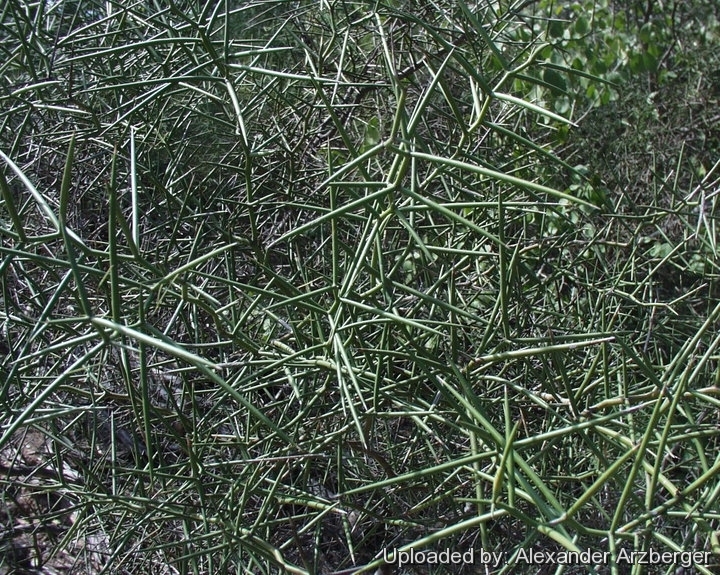




Your support is critical to our success.

Origin and Habitat: South America: centre of Argentina (northern Córdoba, Santa Fe and Corrientes); eastern Bolivia; Paraguay
Habitat and ecology: Prosopis kuntzeiSN|34178]]SN|34178]] is a normal component of the climactic Chaco forest (mixed sub-xerophytic forests), but is able to colonize the overgrazed savannah, eventually forming pure stands. Morello et al. (1971). The xerophytic species grows either solitary or in pure stands.
Synonyms:
- Prosopis kuntzei Harms ex Kuntze
Prosopis kuntzei Harms ex Kuntze
Revis. Gen. Pl. 3[3]: 71. 1898 [28 Sep 1898]
Synonymy: 3
- Prosopis kuntzei Harms ex Kuntze
- Prosopis barba-tigridis Stuck.
- Prosopis casadensis Penz.
ENGLISH: Prosopis
SPANISH (Español): Barba de Tigre, Carandá, Itin, Jucarandá, Lanza-lanza, Palo Mataco, Yacarandá, Algarrobo, Yacaranda itin
Description: Prosopis kuntzeiSN|34178]]SN|34178]] is a very branchestem-photosynthesizing tree (4-10 m tall) with reduced foliage and formidable sharp thorns 8-50 cm long that cover the whole adult tree. After a leafy juvenile period the plants continue in an apophyllous condition in which the photosynthesizing activity is mainly taken over by assimilating thorns (cylindrical cladodes and branches). The species is bare of leaves most of the year. The leaves appear early in the spring, but are shed soon afterwards. The tree flowers and fruits plentifully in very dry years.
Stem: Trunk twisted, usually less tham 2 m tall and 44-70 cm in diameter. Crown irregular, umbrella-like or rounded. Branches very graceful and flexible to rigid and long, spiny and glabrous. Thorn rigid, straight, cylindrical, multinodal 8-50 cm long. In leaf axils very peculiar club-shaped mucilaginous emergences are formed.
Leaves: The leaves are small and fall very early in spring after the development of the young shoot, which becomes a thorn. The leaves are bipinnate with 2-5 pairs of leaflets of secondary order, 5-10 mm long and 3-5 mm broad. Petiole of 5 mm.
Inflorescence: Solitary or clustered, 3-7 cm long.
Flowers: White or yellow, perfumed, outside of the calyx glabrous, about 1 mm across, corolla 3 mm long. Style hairy.
Phenology: The flowers appear in November and December. The new shoots with deciduous leaves appear between July and November.
Fruits (legumes): About 10-17 cm long, 15-26 mm broad, and 6-15 mm thick, light brown-violet to dark violet, thick-turgid, slightly woody, more or less compressed and straight or slightly sickle-shaped. Indehiscent (not splitting open at maturity). The pulp is dry floury, and strongly perfumed.
Seeds: Compressed oval, brown, 7-10 mm long by 5-6 mm wide.
Notes: The spines of Prosopis kuntzeiSN|34178]]SN|34178]] are impressive (they may reach more than 50cm) and cover the whole adult tree. This contrasts with many of the heavily thorny African acacias which lose their thorns when they reach canopy heights of five meters - the upper level of browsing by giraffes (Cummings 1982). Such defences seem excessive when related to the modest set of contemporary Chacoan herbivores. Perhaps an "anachronistic" adaptation against large herbivores such as the extinct Megatherium? The large spines covering the whole tree may have proven necessary against a huge Megatherium, "a browser pulling branches to their mouth while standing semi-erect, supported by its massive tail" (Martin & Klein 1984).
Bibliography: Major references and further lectures
1) Frank Bisby “Phytochemical Dictionary of the Leguminosae” CRC Press, 18 August 1994
2) “WiNR” Published jointly by the College of Forestry, Wildlife and Range Sciences and the Laboratory of Anthropology, University of Idaho, 1995
3) P. G. Ozenda “Handbuch der Pflanzenanatomie”, Volumi 14-15 Borntraeger, 1997
4) Enrique H. Bucher “Herbivory in arid and semi-arid regions of Argentina - Herbivoría en regiones árid as y semiáridas de Argentina” Revista Chilena de Historia Natural 60: 265-273, 1987
5) Martin P & R kein (Eds.) (1984) “Quaternary extinctions.” University of Arizona Press, Phoenix, Arizona
6) Bocher T.W., 1982: “A developmental analysis of the photosynthesizing organs in prosopis kuntzei.” Kongelige Danske Videnskabernes Selskab Biologiske Skrifter 23(4): 3-50
7) Burkart A.. 1976. “A Monograph of the Genus Prosopis”. Journal Arn. Arb. 57 (3–4)
8) Burkart, A. .1940. “Materiales para una Monografía del Género Prosopis”. Darwiniana 4: 57–128
9) Giménez A., et al. 1997. “Diámetro mínimo de corta vs las posibilidades de crecimiento en especies arbóreas de la región Chaqueña Seca”. INSIMA.Fac.Cs Forestales. Santiago del Estero. XIX Reunión Argentina de Ecología. Tucumán -
10) Legname, P. 1982. “Arboles indígenas del NW Argentino”. Opera Lilloana XXXIV. Tucumán Morello, J.N. Et al. 1971. “Los Vinalares de Formosa”. INTA. Serie fitogeográfica No 11. Bs. As.
11) Tortorelli, L. 1956. “Maderas y Bosques argentinos”. Bs.As.
12) Roig,F.A. 1993. “Informe Nacional para la Selección de Germoplasma en Especies de Prosopis en la Republica Argentina” IADIZA- CRICYT.
13) Cummings DHM (1982) “The influence of large herbivores on savanna structure in Africa.” In Huntley B & B Walker (Eds.) “Ecology of Tropical Savannas”: 217-245, Springer Verlag, Berlin.
14) Kishan Gopal Ramawat “Desert Plants: Biology and Biotechnology” Springer Science & Business Media, 16 December 2009
Cultivation and Propagation: Prosopis kuntzeiSN|34178]]SN|34178]] growth is slow; the tree reaches about 1.5—2 m in height during the first 4 years.
Main uses: Posts, poles, fuelwood, charcoal. The wood is hard, flexible, bluish-black, and was used by the Chaco Indians for bows and spears. Prosopis kuntzeiSN|34178]]SN|34178]] is the species that possesses the greatest calorific value of the genus Prosopis; Tortorelli (1956). At present, it is used to build fences and poles due to its resistance to deterioration, and cut for several local uses; It is considered of very valuable wood; Burkart (1976). The fruits are recommended to calm the toothache, for this a piece is inserted into the caries; Roig (1993).
Propagation: Seeds and cuttings. It is advisable to collect the seeds from unripe pods because of insect attacks.
| Your Actions | |
|---|---|
| Back to Prosopis index | |
| Back to Mimosaceae index | |
 |
Back to Trees Encyclopedia index |
Privacy stantement - Terms and conditions - How to cite - About us - Feedback - Donate


